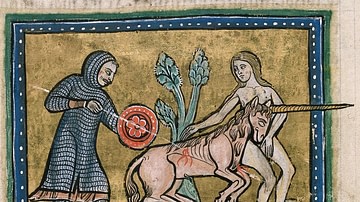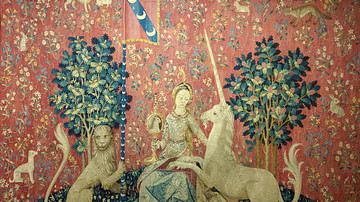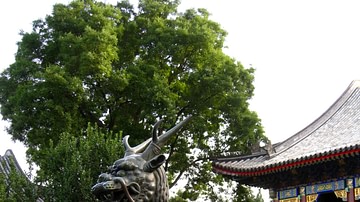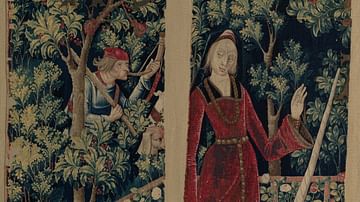
The qilin (麒麟, or simply lin 麟) is a Chinese mythical creature, frequently translated as "Chinese unicorn." While this term may suggest a one-horned creature, the qilin is often depicted with two horns. However, like the Western unicorn, the qilin was considered pure and benevolent. A rarely seen auspicious omen, the qilin heralds virtue, future greatness, and just leadership.
Throughout history, the qilin can be found in Chinese literature, art, and accounts of day-to-day life. As one of the Four Auspicious Beasts – alongside the dragon, phoenix, and tortoise – the qilin also embodies prosperity and longevity and has a heavenly status. References to the qilin date back to ancient Chinese texts, where this revered creature is regarded as a sign of good fortune and an indicator of a virtuous ruler. Its association with the philosopher Confucius (l. c. 551 to c. 479 BCE) underscores its significance as an auspicious symbol. Qilin imagery was favoured across various Chinese dynasties, and its popularity extends across other Asian countries, including Japan, Korea, and Vietnam.
The Qilin in Classical Texts
In the classic The Book of Rites (also known as the Liji, date uncertain), the qilin is listed as one of the four intelligent creatures along with the phoenix, dragon, and tortoise, often referred to as the Four Auspicious Beasts. Each of these divine creatures symbolizes different virtues considered essential for successful and harmonious coexistence. Broadly, the dragon symbolizes power and strength, the phoenix renewal and grace, the tortoise longevity and stability, and the qilin prosperity and righteousness. Together, these beings convey a collective message of good fortune and balance.
The Classic of Mountains and Seas (the Shanhai jing, 4th century BCE), a proposed mythological geography of foreign lands, mentions several one-horned beasts, but none are specifically identified as the qilin. The earliest known reference to the qilin in ancient texts can be traced back to the Western Zhou period (1045-771 BCE), which is the first half of the Zhou dynasty, the longest-lasting dynasty in Chinese history. The qilin also appears in the Shijing, also called The Book of Odes or Classic of Poetry, said to have been compiled by Confucius in the 4th century BCE, making it the oldest extant poetry collection in China. The Shijing contains just over 300 poems and songs, with some thought to be written between c. 1000 to c. 500 BCE. The piece in question, "The Feet of the Lin", appears at the end of the section that captures the voices of the common people. From Bernhard Kalgren's translation, The Book of Odes (1950):
The feet of the lin! You majestic sons of the prince! Oh, the lin!
The forehead of the lin! You majestic kinsmen of the prince! Oh, the lin!
The horns of the lin! You majestic clansmen of the prince! Oh, the lin!
Here, lin refers to the qilin, and its defining physical features are likened to regal offspring and relations. Karlgren calls this "a simple hunting song, and an exclamation of joy" (7) and suggests it was originally about a real but rare animal, such as a type of deer, which became a fantastical legend later. In James Legge's translation of the same poem, he notes that the qilin had a deer's body, ox's tail, horse's hooves, a single horn, and fish scales. The qilin's feet are not used to harm any living thing, even grass; it never butts with its head, and does not attack with its horn. As a popular and freely available translation, these notes are frequently cited and show the qilin as supremely peaceful and benevolent by choice.
In the 5th century BCE, we find the qilin, again mentioned as the lin, in The Spring and Autumn Annals, a historical record of events occurring in the state of Lu. This chronicle records that a lin was captured in the 14th year of Lord Ai's rule, 481 BCE. Later scholars analyzed and attributed great significance to this event, as Confucius himself, the compiler of The Spring and Autumn Annals, might have done.
From James Legge's translation of The Chinese Classics, volume V, 1872, page 832, (translator's square brackets):
In the [duke's] fourteenth year, in spring, [some] hunters in the west captured a lin.
Confucius & the Qilin
Scholars have interpreted these historical records at various levels of symbolic depth. Commentaries on The Spring and Autumn Annals, from as far back as the 4th century BCE, give varying accounts and details about the sighting and subsequent death of the captured qilin. Some scholars consider the appearance of the qilin to have been a marvel that Confucius himself found significant and give the following details. Towards the end of Confucius's life, a qilin was captured by hunters or, some say, firewood collectors. The creature was injured, recognized to be unique, and taken to Confucius. Upon identifying the creature as a qilin, Confucius apparently wept, deeming it a bad omen that the divine qilin had appeared at the wrong time and died of its injuries. Rather than appearing during righteous rule, signifying prosperity, the qilin had appeared under leadership that Confucius found unsatisfactory, in what he thought of as a time of moral decline. Confucius was said to have seen the death of the qilin as a sign that his own death was near and that the Zhou dynasty no longer had the divine right to rule; they had lost the Mandate of Heaven. Two years later, Confucius died.
According to legend, a qilin also appeared to Confucius' mother just before he was born, in some accounts, bearing a jade tablet. For this reason, the qilin continues to be associated with the birth and death of great sages.
Physical Appearance
Written descriptions of the qilin's appearance vary throughout history. Some give the qilin a deer's body, ox's tail, most frequently cloven hooves, a dragon's head, and scales, sometimes with flames emanating from the body. While some modern commentators use this to label the qilin as a chimera – an assortment of parts of other creatures – looking to art history, this appears to be a misinterpretation. It is more that the features of a wide variety of familiar creatures are invoked to show how fabulous and rare the qilin is. In Chinese mythology, the essence and symbolism are paramount, rather than outward appearance. From sculpture to paintings and ceramics to embroidery, the qilin is a popular subject throughout history. While the representation of its physical features has shifted somewhat over time, its essence and symbolism have remained more constant.

In China's capital, Beijing, a large bronze statue of a qilin is found outside the Summer Palace. It has a dragon-like head with two horns, cloven hooves, and fire emanating from its chunky, scaled body. Similar imagery of a qilin with two horns, scales, and cloven hooves was used on rank badges worn from 1453 to 1662 CE on the robes of first-rank military officers. Qilin rank badges were worn in the Ming dynasty (1368-1644 CE) to indicate closeness to the emperor, and the use of the qilin on the military robes of generals dates back to the Tang dynasty (618-907 CE). It is thought that the variation in appearance of the qilin on rank badge designs, even from the same period, is because they were individually tailored at the wearer's expense. Such variation can be seen in the badges found during the excavation of the tomb of Duke Xu Fu (d. 1517 CE), Nanjing. One was a particularly interesting rank badge with a creature like a traditional qilin but with a very long neck. Scholar James C. Y. Watt states that, when compared to paintings of giraffes from the Ming dynasty, it becomes clear that the qilin's appearance was influenced by the giraffe.
The Giraffe as a Qilin
During the Ming dynasty, the Yongle Emperor (r. 1403-1424 CE) was gifted a giraffe by King Saif Al-Din Hamzah Shah of Bengal in 1414 CE. It was thought to be a qilin and an auspicious sign confirming the Yongle Emperor's righteous rule. The Chinese admiral and adventurer Zheng He made seven diplomatic voyages between 1405 and 1433 CE, and he brought back many wonders, including the giraffe, which had never been seen before in China. Many interpreted the giraffe's arrival as the auspicious qilin due to its gentle demeanour and unique appearance. Such an unusual creature indeed made it look to some that The Classic of Mountains and Seas had been right all along. Thus, the qilin-giraffe became a popular cultural image and a tool in international diplomacy.
The qilin's influence extends beyond China. In Japan it is called the kirin, and in Korea it is known as the girin (pronounced "kirin"). Interestingly, in both Japanese and Korean, the word for qilin and giraffe are the same. The symbolism and appearance of the kirin and girin are similar to their Chinese counterpart. In Japan, a one-horned kirin is famously pictured on Kirin Beer, which has been brewed since 1888. In Korea, the girin can have a deer-like hide instead of scales, but it retains its fire. Vietnam's Kỳ Lân shares many similarities with the qilin and is also a symbol of good fortune.
Wider Culture & Modern Interpretations
As a symbol of good luck and protection, the qilin can be included in household feng shui arrangements to promote harmony. Families hoping for children may position representations of the qilin to bless them with children with bright futures, particularly in achieving success and status through education or rising to official positions. An example of this connotation to high status and achievement, in addition to rank badges, was The Qilin Court, a hall built in the Western Han dynasty (206 BCE to 9 CE). It holds portraits of emperor-approved generals and ministers, representing a high honour that celebrates their accomplishments.
During festivals and celebrations, such as Chinese New Year, the qilin dance – a traditional folk dance with connections to martial arts – may be performed. Performers don colourful, decorated costumes and invoke prosperity through their qilin-like movements. Indeed, some forms of qilin dance are seeing a modern revival. Another modern look at the qilin was in the film Fantastic Beasts: The Secrets of Dumbledore, in which some traditional aspects of Chinese mythology were retained.
Conclusion
From ancient mythology to imperial iconography to contemporary media, the qilin embodies timeless values of benevolence and signals virtuous rule. Its depiction in ancient texts and its role in festivals emphasize its importance as a symbol of good fortune and righteousness. The qilin's position as one of the Four Auspicious Beasts and its connection to Confucius further highlights its place in Chinese history. Today, the qilin flourishes in dance, art, feng shui, and entertainment, reflecting its enduring cultural significance across many regions of Asia.











